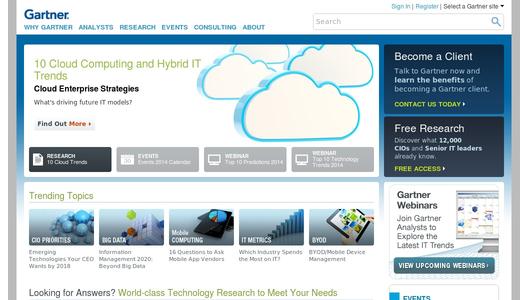"Starting in 2014, the enterprise software markets will undergo their greatest level of disruptions, growth and new opportunities since the year 2000," said Tom Eid, research vice president at Gartner. "By 2017, Gartner estimates that new IT buying based on the Nexus of Forces will drive more than 26 per cent of total enterprise software market revenue, up from 12 per cent in 2012. This represents more than $104 billion to new worldwide enterprise software revenue from cloud, information, mobile and social initiatives in 2017."
Mr Eid said that the nexus forces must be evaluated, analysed and understood as adjacent and synergistic and not solely as independent or nonconnected.
"While there has been a great deal of excitement from the vendor community regarding cloud, information, mobile, social, and other forces and technologies, adoption in organisations and businesses has yet to catch up with the hype," said Mr Eid. "Adoption trends of new technologies frequently take many years before reaching maturity, stability and broad market usage. The nexus should be seen as a development and design philosophy rather than as a packaged product."
While the use of collaboration technologies, data analytics, mobile devices and software as a service (SaaS) have been in effect for more than a decade, their adoption and popularity have increased significantly over the last few years. Vendors' offerings continue to improve, and usage benefits are becoming more tangible. Gartner expects that new revenue generation and growth rates derived from the Nexus of Forces' impact on enterprise software markets will far outpace overall market growth through 2017.
Cloud-Based Services
Cloud and SaaS popularity and adoption have continued to increase since 2008. Buyers are under pressure to mitigate operational costs, evaluating less-capital-intensive alternatives and more modern software. In addition, annual increases in technical support and maintenance fees and business disruption because of upgrades from suite vendors are prompting IT managers to evaluate other options and vendor choices.
Cloud-based offerings need to be tailored to specific needs and requirements. First-time purchases are commonly characterised by short time frames, limited computing requirements, and line-of-business or departmental buying. More comprehensive and mature usage of cloud-based offerings is more strategic and frequently represented by long-term projects to transform technology access/use with oversight and funding from IT management.
Information, Analytics and Content
While business intelligence (BI) and analytics have been a top CIO priority for years, recent purchasing patterns show that spending with CIOs is in more of a "wait and see" mode. Most net new spending is currently driven from outside the IT department. BI, analytics and data analysis are well-established for most large companies in traditional subject areas, such as finance and sales, but there is still extensive growth potential for diagnostic, predictive and prescriptive projects.
The emerging data-as-a-service trend is anticipated to significantly grow the market for BI and analytic platforms. Today, the business model is largely "build" driven. Organisations licence software capabilities to build analytic applications. However, organisations increasingly will subscribe to industry-specific data services that bundle a narrow set of data with BI and analytic capabilities embedded.
Enterprise content management (ECM) can be viewed as both a business-IT strategy as well as a set of software technologies. As an IT strategy, ECM helps organisations take control of their content and, in so doing, boost effectiveness, encourage collaboration and make information easier to share. As software technologies, ECM consists of applications for content life cycle management that interoperate, but that can also be sold and used separately.
Mobile and social forces are frequently leveraged for new ECM projects with purchasing from line-of- business managers and marketing/sales groups. New strategic and sophisticated ECM initiatives are being funded at the CxO level to focus on information governance and regulatory compliance requirements.
Mobility
Emphasis over the next few years will be on providing enterprise-class support for mobile data and applications, rising on top of the existing enterprise mobile architectures. This will be driven by key technologies, such as enterprise mobile management systems (EMMSs), mobile containers, enterprise application stores and mobile collaboration.
Tablet and mobile users are demanding mobile device applications that exploit the capabilities of these devices and that can integrate into existing corporate systems. This trend is pushing the application software market in a new direction, and a mobile application product strategy has become a strategic imperative for all application vendors.
Social and Collaboration
The promise of the converging social, mobile, cloud and information forces is directly relevant to delivering successful collaboration and social software initiatives.
For many organisations, first-time internal usage of social and collaboration software is primarily focused on individual and small-group communication and sharing. For organisations that are looking to move from an initial or trial phase to a richer experience and more sophisticated stage of usage, emphasis shifts to focusing on collaboration in the context of work activities. This includes enterprise-level commitments for collective intelligence, community building, knowledge sharing and virtual teaming as key drivers of expanding and enhancing usage. IT managers need to work with their users so that social and collaboration software blends naturally with the tasks they need to carry out every day.
More detailed analysis is available in the report "Market Trends: Monetizing Gartner's Nexus of Forces in the Enterprise Software Markets." The report is available on Gartner's web site at http://www.gartner.com/....

